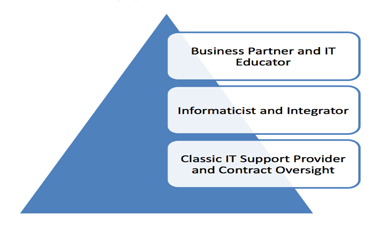A Study of CIO Roles and Effectiveness in Higher Education

The Chief Information Officer role in higher education is a very complex position, and the people filling it are equally complex. This role has been in existence for approximately 25 years, but the CIO career path is not as well-defined a road, as for example a Chief Financial Officer's, which has had a much longer time to become standardized. But, in spite of our "new" executive position and somewhat obscured journey into this key IT leadership role, we are here to stay. We need to help the next generation by defining the role of the CIO in higher education, along with some pathways to it. I have been studying higher education CIOs since 2004 and my study, The Study of the Higher Education Chief Information Officer Roles and Effectiveness, has entered its fifth edition. Here's a brief glimpse at this work along with some useful links and references.
In conducting this year's research, all CIOs from two- and four-year higher education institutions in the US were surveyed, and 352 CIOs responded. The management teams from those 352 CIOs' institutions were sent a second survey. One hundred and twenty-four institution management team (IMT) members responded, representing 100 of the 352 responding-CIO institutions. The two-part survey remains a unique approach to the study of the higher education CIO, their effectiveness, attributes, and how the IMT views them. This study methodology is based on Dr. Herb Smaltz's 1999 doctoral healthcare CIO research.
While much information has been gleaned from the survey results, the heart and soul of it is the unique approach it takes to perceived CIO effectiveness in six different IT leadership roles: Business Partner, Classic IT Support Provider, Contract Oversight, Informaticist and IT Strategist, Integrator, and IT Educator. In addition to these roles, the survey looks at the importance of the roles, and the attributes, and conditions that might impact CIO effectiveness. The CIO roles include the following responsibilities:
Business Partner - Organizational strategic planning and revising business processes
Classic IT Support Provider - Foundations of IT support and responsive department
Contract Oversight - Relationships with IT vendors, contract negotiation, and contract supervision
Informaticist and IT Strategist - Ensure security and accuracy of institutional data and alignment of IT department with the institution
Integrator - Integration of all internal and external systems
IT Educator - Evangelist for computer use and understanding; educator of employees on how IT innovations bring value to the organization
Aggregated responses are used for comparison between the two groups' (CIO and IMT) perspectives on role importance and effectiveness. Role importance is ranked from 1, no importance, to 5, critically important. The effectiveness scale is from 1, expectations not met, to 5, outstanding. CIOs have consistently rated themselves and have been rated as effective by their supervisors and peers.
One of the interesting trends to emerge from the study is that the foundation roles of Classic IT Support Provider and Contract Oversight have been consistently singled out as the most important and the most effective roles for the CIO by both CIOs and the IMT (Brown, 2006a, 2006b, 2008a, 2008b). In contrast, the least important and least effective roles have also been consistent: Business Partner and IT Educator. Perhaps surprisingly, it's the latter roles that the CIOs would like to spend more time working at--sitting at the leadership table and being involved in the planning for the institution, and educating the institution on the value of IT. Of course, having this information prompts the question, if those latter roles are so important to CIOs, why are they consistently at the bottom of the list for importance and effectiveness?
One theory might be that it's a case of meeting basic needs before moving on to more complex issues. There might be a Maslow Hierarchy of Needs comparison that can be made to the CIO roles (Wagner, 2009). The CIO cannot move on to those higher-level functions until the institution's more basic needs are met, basic needs in the form of the Classic IT Support and Contract Oversight roles. The figure below depicts how this CIO Role Hierarchy looks. As the study continues, this Maslow comparison will be explored as a possible explanation for this ongoing role importance and effectiveness trend.
Another interesting trend that has evolved from the study during the past two years is the projected CIO retirement wave. In 2008, 47 percent of the higher education CIOs were anticipating their retirement in the next 10 years. In 2009, that percentage has remained relatively stable at 45 percent. This coming retirement exodus is cause for concern because we are a new profession and the career path is not carved in stone. This lack of a career path makes it difficult for people entering the profession to make choices that make them competitive for CIO positions, and the people hiring the CIOs may also be unclear about the attributes they want their future CIOs to possess. The projected CIO retirement exodus also raises questions for the people in the next layer down from the CIO in the IT organization. Do they want to be the CIO? Are they preparing/being prepared for this job? What are their retirement plans? In 2009, we will launch a study, Higher Education Technology Leadership Study: The CIOs of the Future, to examine these and other questions about the next generation of IT leadership.
You'll notice a new name associated with this research project going forward: Center for Higher Education Chief Information Officers Studies (CHECS) Inc. In the past, I have personally funded the survey, its publication, and the distribution of study results. While I do love the subject, that financial burden combined with the enormous amount of work that goes into a survey and study of this kind, plus wanting to give the research a "home," has motivated me to establish a nonprofit organization. To this end, CHECS was created in 2009. The purpose of CHECS is to contribute to the education and professional development of the CIO in higher education. CHECS will allow me to fund the research through sponsorships, such as our 2009 sponsors, Excelsior College, SunGard Higher Education, and Thanos Partners, andthrough the sale of the annual CIO study report. For more information on thework of CHECS and to download study reports, visit www.checs.org.
References
Brown, W. (2006a). Chief Information Officer Effectiveness in Higher Education. EDUCAUSE Quarterly, 29(1).
Brown, W. (2006b). The Two Year College and The Chief Information Officer. Leadership Abstracts, 19(5).
Brown, W. (2008a). Higher Education CIOs: Are they effective? Retrieved April 28, 2008, from http://www.govtech.com/pcio/articles/303908.
Brown, W. (2008b). Portrait of Information Technology Leaders in Higher Education: 2008 Study of the Higher Education Chief Information Officer Roles and Effectiveness. Phoenix: League for Innovation in the Community College.
Wagner, K. V. (2009). Hierarchy of Needs. Retrieved April 25, 2009, from http://psychology.about.com/od/theoriesofpersonality/a/hierarchyneeds.htm